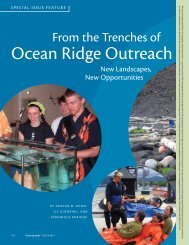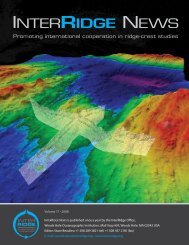Full version, low resolution, 7.5MB - InterRidge
Full version, low resolution, 7.5MB - InterRidge
Full version, low resolution, 7.5MB - InterRidge
You also want an ePaper? Increase the reach of your titles
YUMPU automatically turns print PDFs into web optimized ePapers that Google loves.
Third Decadal Plan<br />
From Ridge Crest to Deep-Ocean Trench: Formation and<br />
Evolution of the Oceanic Crust and Its Interaction with the<br />
Ocean, Biosphere, Climate and Human Society<br />
A plan for the third decade of <strong>InterRidge</strong> science<br />
<strong>InterRidge</strong> is the only scientific organisation that spans the single<br />
largest geological domain on the planet: the Earth’s oceanic crust,<br />
representing more than 60% of the Earth’s surface. The background<br />
for this framework is the recognition of a number of key areas of<br />
research that are needed to underpin our developing understanding<br />
of the formation and evolution of the oceanic crust and its<br />
interaction with the ocean, biosphere, climate and human society.<br />
The role of <strong>InterRidge</strong> has evolved from facilitating cooperation<br />
between ridge crest scientists to helping science focus on the major<br />
and fundamental aspects of ocean crust generation and evolution;<br />
from genesis at the ridge crest, to evolution on the flanks and under<br />
the abyssal plains to its fate at convergent margins, subduction zones,<br />
arcs and back-arc systems.<br />
The fol<strong>low</strong>ing sections describe the results of a process of<br />
consultation of the <strong>InterRidge</strong> community that was initiated in 2011<br />
through an online forum and culminated on December 3 rd 2011 at<br />
an open meeting in San Francisco. Fol<strong>low</strong>ing summaries from the<br />
current and future working groups, the process of science<br />
prioritisation was led by the <strong>InterRidge</strong> Chair (Bramley Murton) with<br />
assistance from three previous Chairs (Colin Devey, Jian Lin and<br />
Roger Searle). All of the attendees were asked to post their key<br />
scientific questions on a bulletin board. These were then organised<br />
into broad scientific themes. Attendees were then asked to self<br />
organise into groups under each of the science themes and draw up<br />
a list of the big scientific questions, their context and background,<br />
and how they might be implemented. Each group then elected one<br />
or two members that formed the writing group on the 4 th December<br />
to compile each of the report sections presented here.<br />
Past and present Chairs at the Third Decadal Plan meeting in San<br />
Francisco, December 2011 (Colin Devey, Bramley Murton, Jian<br />
Lin, Roger Searle).<br />
Section A<br />
Mid-Ocean Ridge Tectonic and Magmatic Processes<br />
Three-dimensional perspective<br />
image of ridge-ridge-ridge triple<br />
junction in the Indian Ocean<br />
(Rodriguez triple junction, 25°30'S,<br />
70°00'E). The deep valley in the<br />
bottom left corner is the<br />
Southwest Indian Ridge axial<br />
valley. A typical oceanic core<br />
complex and other domed<br />
features are located along the<br />
boundary of first and second<br />
segments of the Central Indian<br />
Ridge, where mantle and/or <strong>low</strong>er<br />
crustal rocks are exposed. Data<br />
acquired during KH93-3, KR00-<br />
05, YK01-15, YK05-16, YK09-13,<br />
KH10-6 (Japan) and previous<br />
French cruises in 1990's.<br />
INTERRIDGE NEWS 2 VOL.21, 2012
















